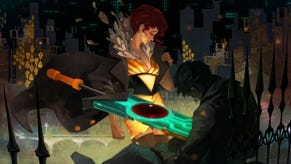Thief: opening the door to the next generation
Thief gives Stace Harman a first-hand glimpse into the spectacle of next-gen games, but underlines how even with extra power behind them, some things never change.
Watching Eidos Montreal’s Thief demo on PC, I’m struck by two things. The first is the aesthetically pleasing display of dynamic lighting, volumetric smoke, god-rays and weather effects that’s being delivered to my eyeballs. The second is just how completely it is undermined by the simple act of opening a door.
The play-through I’m watching is that which was concisely described by Dave a little while back.
In it, master thief Garrett scales the rooftops of a darkened cityscape in order to orientate himself, prior to hot-footing across town to reach the House of Blossoms brothel before the clock strikes 12.
Eschewing the heavily guarded front door of the pleasure house for a conveniently overlooked hole in the wall, Garrett slips inside, incapacitates a guard, burglarises a strongbox and pick-pockets a patron.
All actions are expertly carried out without raising suspicion as Garrett surreptitiously extinguishes light sources to facilitate his slinking through the shadows. It’s atmospheric, moody and watching Garrett ply his illicit trade provides an undeniable frisson of excitement.
And then he opens a door and my brain pulls a sad face.
We’ve all seen it play out a thousand times before: player gets within a few feet of a conventional door, player presses button on controller, door swings open without being touched by avatar. It’s a very familiar scenario and that’s precisely the cause of my consternation.
Where is Garrett’s natural caution? Why doesn’t he ease the door open and peek round it? Why is the door either wide open or shut tight? There’s an immediate sense of disconnect between player, avatar and game-world that’s caused by such mundane trifles as having a door swing open without being touched.
It’s something that we’ve grown used over the years but equally it’s something that could become increasingly difficult to accept or ignore as we move toward the brave new world of next-gen.
Putting this to Thief producer Stephane Roy elicits a thoughtful pause before he delivers an unexpected answer, “It’s a tradition, if I may call it that, that’s known throughout the video game industry: doors are a pain in the arse.”
“In terms of the AI understanding the role that doors play, how to navigate them, how they affect the layout of a room ... in real life opening a door is nothing but in a game it’s more complicated. Then there’s the animation of the action and the angles from which a player can perform it; it’s a lot of work. That said, I agree, this is next-gen and the idea that there is some kind of magic door that just swings open is not good.
“The most important thing for us is immersion and that you believe in this world. This type of detail can undo that. I cannot promise you anything but I am certainly putting some pressure on people on my team to find solutions to these kinds of problems.”
Of course, the opening of a door is merely representative of a host of accepted conventions and immersion-breaking problems to be addressed by Thief and its next-gen brethren. Guards incapable of looking up, amnesiac AI outfoxed by breaking its line of sight, gimmicky super-powered vision that highlights objectives and provides solutions to puzzles.
There are a lot of things that we’ve gotten used to seeing in our games that developers of next-gen titles are going to have the power to address. The question is: will they?
Sumptuous visuals aside, it’s disappointing to see a next-gen game being played in exactly the same way as a current-gen title. However, what’s more encouraging is the conversation that I have with Roy afterwards in which he addresses many of these concerns.
For example, he speaks of how the increased processing power of next-gen machines allows for AI to be managed on many more levels than is currently possible and how it will facilitate a more seamless transition between states of awareness.
What’s more, veteran guards can display more complex behaviour patterns than low-level rookies, meaning that tricks that work against some AI entities won’t necessarily work in the same way against others.
“For us, the big thing with the next generation is how it will allow us to really concentrate on creating an immersive experience,” Roy reiterates. “We’re having a lot of conversations internally about how to address issues and ensure that the world feels believable.”
It’s at this point that I bring up Focus, Garrett’s vision-altering power that will be familiar to players of Tomb Raider, Batman, Hitman, Assassin’s Creed and a host of other games. Here, Focus is a limited resource that can be used to highlight objects, aid pickpocket and lock-picking attempts, and facilitate takedowns during combat.
Thief director Nicholas Cantin has previously stated that use of this power will be “completely the player’s choice”, but in the level I watch, Garrett uses it to uncover hidden glyphs to solve a mission-critical puzzle and there really doesn’t appear to be any other way to achieve that without using Focus.
“The Focus is really linked with the story, something happens at the beginning of the story that makes sense of it ... we’ve worked very hard to make sure that it doesn’t feel like a video game gimmick and having said that its use will be optional, we have to work very hard to make sure of that,” Roy explains. “If we have a puzzle that all of the people in this city cannot solve [without Focus], then we have to be able to explain why that is.”
Reading between the lines it seems likely that, as things stand, the use of Focus during moment-to-moment game play will be optional but that Garrett’s reliance on it in other instances is inextricably tied to the narrative.
In truth, this first 30-minute look at Thief raises more questions than Roy has time to answer. He promises future demos will better illustrate how the AI behaves and how myriad approaches will affect the way a level plays out, but that will have to wait for another day.
In the meantime, it’s exciting to imagine how light and shadow, a contrast that has always played a fundamental role in Thief series, might affect game play. The possibilities that could be explored through clever use of dynamic light-sources, real-time shadows and genuine reflections could fundamentally enhance the Thief experience beyond anything that is currently possible on PS3 and 360.
Of course, video game conventions are not going to change overnight. It’s going to be a while before we find out whether Thief, or indeed any of the first-wave of next-gen exclusive titles, will offer a genuinely new experience or, at the very least, more than just a shiny new wrapper.
To paraphrase Roy, for me the next gen is less about the number of polygons being pushed around the screen and more about what those polygons are doing. I just hope that extends to how they open doors.
Thief will launch on PC, PS4 and “other next-generation consoles” in 2014.




















